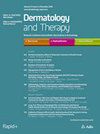投稿信息
稿件收录要求
Dermatology and Therapy is an international, open access, peer-reviewed, rapid publication journal (peer review in 2 weeks, published 3–4 weeks from acceptance). The journal is dedicated to the publication of high-quality clinical (all phases), observational, real-world, and health outcomes research around the discovery, development, and use of dermatological therapies. Studies relating to diagnosis, pharmacoeconomics, public health and epidemiology, quality of life, and patient care, management, and education are also encouraged.
Areas of focus include, but are not limited to all clinical aspects of dermatology, such as skin pharmacology; skin development and aging; prevention, diagnosis, and management of skin disorders and melanomas; research into dermal structures and pathology; and all areas of aesthetic dermatology, including skin maintenance, dermatological surgery, and lasers.
The journal is of interest to a broad audience of pharmaceutical and healthcare professionals and publishes original research, reviews, case reports, trial protocols, and short communications. The journal appeals to a global audience and receives submissions from all over the world. Articles published in Dermatology and Therapy may be accompanied by Plain Language Summaries to assist non-experts (including non-specialists, patients, caregivers and others) in understanding important medical advances.
Moving forward from traditional publishing, Dermatology and Therapy offers a range of additional enhanced features designed to increase visibility, readership, and the educational value of the content. Each paper is accompanied by a bulleted Summary slide, giving a time-efficient overview of the content to a wide readership. Articles also have the option to include various other types of enhanced features including slide sets, videos and animations. All enhanced features are open access and are peer reviewed to the same high standard as the article itself. For questions relating to enhanced features please contact adisdigitalfeatures@springer.com.
Dermatology and Therapy is published under the Creative Commons Attribution-Noncommercial License, which allows users to read, copy, distribute, and make derivative works for non-commercial purposes from the material, as long as the author of the original work is cited. The author assigns the exclusive right to any commercial use of the article to Springer. For more information about the Creative Commons Attribution-Noncommercial License, click here: http://creativecommons.org/licenses/by-nc/4.0.
Upon acceptance of your article for publication, you will be required to pay the article processing charge of €340/ $380 per printed page. This will enable you to keep the copyright; you are simply assigning the exclusive right to any commercial use of the article to Springer. Your article will be immediately and permanently available with open access. The journal will consider fee discounts for developing countries and this is decided on a case by case basis.
Peer Review Process
Upon submission, manuscripts are assessed by the editorial team to ensure they fit within the aims and scope of the journal and are also checked for plagiarism. All suitable submissions are then subject to a comprehensive double-blind peer review. Reviewers are selected based on their relevant expertise and publication history in the subject area. The journal has an extensive pool of editorial and advisory board members who have been selected to assist with peer review based on the afore-mentioned criteria.
At least two extensive reviews are required to make the editorial decision. Where reviewer recommendations are conflicted, the editorial board will be contacted for further advice and a presiding decision. Manuscripts are then either accepted, rejected or authors are required to make major or minor revisions (both reviewer comments and editorial comments may need to be addressed). Once a revised manuscript is re-submitted, it is assessed along with the responses to reviewer comments and if it has been adequately revised it will be accepted for publication. Accepted manuscripts are then copyedited and typeset by the production team before online publication. Appeals against decisions following peer review are considered on a case by case basis and should be sent to the journal editor.




